Edaphosaurus
| Edaphosaurus Temporal range: Late Carboniferous - Early Permian, 300–280 Ma | |
|---|---|
| | |
| Restored specimen of E. boanerges, AMNH | |
| Scientific classification | |
| Kingdom: | Animalia |
| Phylum: | Chordata |
| Clade: | Synapsida |
| Family: | †Edaphosauridae |
| Genus: | †Edaphosaurus Cope, 1882 |
| Type species | |
| †Edaphosaurus pogonias Cope, 1882 | |
| Species | |
| Synonyms | |
Edaphosaurus (/ˌɛdəfoʊˈsɔːrəs/, meaning "pavement lizard" for dense clusters of teeth) is a genus of extinct edaphosaurid synapsid that lived around 300 to 280 million years ago, during the late Carboniferous to early Permian periods. The American paleontologist Edward Drinker Cope first described Edaphosaurus in 1882,[1] naming it for the "dental pavement" on both the upper and lower jaws, from the Greek edaphos/εδαφος ("ground"; also "pavement") and σαυρος/sauros ("lizard").
Edaphosaurus is important as one of the earliest known large plant-eating (herbivorous) amniote tetrapods (four-legged land-living vertebrates). In addition to the large tooth plates in its jaws, the most characteristic feature of Edaphosaurus is a sail on its back. A number of other synapsids from the same time period also have tall dorsal sails, most famously the large apex predator Dimetrodon. However, the sail on Edaphosaurus is different in shape and morphology. The first fossils of Edaphosaurus came from Texas in North America, with later finds in New Mexico, Oklahoma, West Virginia, and Ohio. Fragmentary fossils attributed to Edaphosaurus also have been found in the Czech Republic and in Germany in Central Europe.
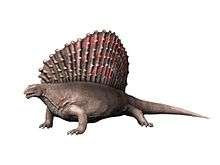
Etymology
The name Edaphosaurus, meant as "pavement lizard",[2] is often translated inaccurately as "earth lizard", "ground lizard", or "foundation lizard" based on other meanings for the Greek edaphos, such as "soil, earth, ground, land, base" used in Neo-Latin scientific nomenclature (edaphology). However, older names in paleontology, such as Edaphodon Buckland, 1838 "pavement tooth" (a fossil fish), match Cope's clearly intended meaning "pavement" for Greek edaphos in reference to the animal's teeth.
Description and paleobiology
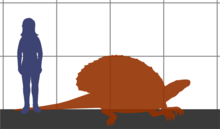
Edaphosaurus species measured from 0.5 metres (1.6 ft) to almost 3.5 metres (11.5 ft) in length and weighed over 300 kilograms (660 lb).[3][4] In keeping with the tiny head, the cervical vertebrae are reduced in length, while the dorsal vertebrae are massive, the tail is deep, the limbs are short and robust and the ribs form a wide ribcage. Like most herbivores, Edaphosaurus would have had a capacious gut and symbiotic bacteria to aid in the breakdown of cellulose and other indigestable plant material.[4] Like its more famous relative Dimetrodon, Edaphosaurus had a sail-like fin that was supported by bones of the vertebral column. Edaphosaurus differs from Dimetrodon in having cross-bars on the spines that supported its fin.[5]
Skull
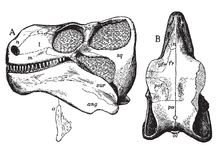
The head of Edaphosaurus was short, relatively broad, triangular in outline, and remarkably small compared to its body size. The deep lower jaw likely had powerful muscles and the marginal teeth along the front and sides of its jaws had serrated tips, helping Edaphosaurus to crop bite-sized pieces from tough terrestrial plants. Back parts of the roof of the mouth and the inside of the lower jaw held dense batteries of peglike teeth, forming a broad crushing and grinding surface on each side above and below. Its jaw movements were propalinal (front to back). Early descriptions suggested that Edaphosaurus fed on invertebrates such as mollusks, which it would have crushed with its tooth plates. However, paleontologists now think that Edaphosaurus ate plants, although tooth-on-tooth wear between its upper and lower tooth plates, indicates only "limited processing of food" [6] compared to other early plant-eaters such as Diadectes, a large non-amniote reptiliomorph (Diadectidae) that lived at the same time. Early members of the Edaphosauridae such as Ianthasaurus lacked tooth plates and ate insects.
Sail
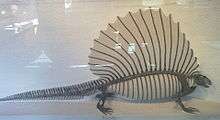
The sail along the back of Edaphosaurus was supported by hugely elongated neural spines from neck to lumbar region, connected by tissue in life. When compared with the sail of Dimetrodon, the vertebral spines are shorter and heavier, and bear numerous small crossbars. Edaphosaurus and other members of the Edaphosauridae evolved tall dorsal sails independently of sail-back members of the Sphenacodontidae such as Dimetrodon and Secodontosaurus that lived at the same time, an unusual example of parallel evolution. The function(s) of the sail in both groups is still debated. Researchers have suggested that such sails could have provided camouflage, wind-powered sailing over water, anchoring for extra muscle support and rigidity for the backbone, protection against predator attacks, fat storage areas, body temperature control surfaces, or sexual display and species recognition. The height of the sail, curvature of the spines, and shape of the crossbars are distinct in each of the described species of Edaphosaurus and show a trend for larger and more elaborate (but fewer) projecting processes over time. Romer and Price [7] suggested that the projections on the spines of Edaphosaurus might have been embedded in tissue under the skin and might have supported food-storage or fat similar to the hump of a camel. Bennett [8] argued that the bony projections on Edaphosaurus spines were exposed and could create air turbulence for more efficient cooling over the surface of the sail to regulate body temperature. Recent research [9] that examined the microscopic bone structure of the tall neural spines in edaphosaurids has raised doubts about a thermoregulatory role for the sail and suggests a display function is more plausible.
Species
| Species | Authority | Location | Status | Synonyms | Images |
|---|---|---|---|---|---|
| Edaphosaurus boanerges | Romer & Price, 1940 | Texas | Valid |  | |
| Edaphosaurus colohistion | Berman, 1979 | West Virginia | Valid | ||
| Edaphosaurus cruciger | Cope, 1878 | Texas and Oklahoma | Valid |  | |
| Edaphosaurus microdus | Cope, 1884 | Texas | Valid | Naosaurus microdus | |
| Edaphosaurus novomexicanus | Williston & Case, 1913 | New Mexico | Valid |  | |
| Edaphosaurus pogonias | Cope, 1882 | Texas | Valid | 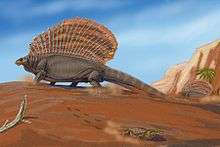 | |
| Edaphosaurus raymondi | Case, 1908 | Texas | Valid | ||
Discovery and classification
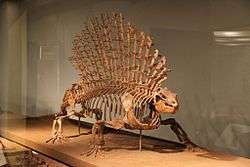
Edward Drinker Cope named and described Edaphosaurus ("pavement lizard") in 1882,[1] based on a crushed skull and a left lower jaw from Texas. He noted in particular the "dense body of teeth" on both the upper and lower jaws, and used the term "dental pavement" in a table in his description. The type species name pogonias means "bearded" in Greek, referring to the enlarged inward sloping chin on the lower jaw. Cope classified Edaphosaurus as a member of his Pelycosauria and created the new family Edaphosauridae. The type material did not include any of the post-cranial skeleton apart from an axis vertebra and Cope was unaware of the animal’s large sail, a feature then known only for Dimetrodon.
In 1886, Cope [10] erected the new genus Naosaurus "ship lizard" (from Greek naos "ship") for skeletal remains similar to those of the long-spined Dimetrodon but with distinctive "transverse processes or branches which resemble the yardarms of a ship's mast". He speculated that "the yardarms were connected by membranes with the neural spine or mast, thus serving the animal as a sail with which he navigated the waters of the Permian lakes". He recognized three species: Naosaurus claviger "club-bearer" (for the projections on its spines; now considered a synonym of Edaphosaurus pogonias); Naosaurus cruciger "cross-bearer" (for the projections on its spines; first described by Cope as Dimetrodon cruciger in 1878; now Edaphosaurus cruciger, the largest species in size); and Naosaurus microdus "small tooth" (first described as Edaphosaurus microdus in 1884). Cope noted some incomplete skull material found associated with the specimens of N. claviger and N. microdus, but thought Naosaurus was distinct from Edaphosaurus. He later decided that Naosaurus must have had a large carnivorous skull similar to Dimetrodon, although he had no direct fossil proof.
In 1907, the American paleontologist Ermine Cowles Case [11] suggested that the skull of Edaphosaurus might belong with skeletons called Naosaurus, based on a specimen found in 1906 that appeared to associate elements of both. In 1913, Samuel Wendell Williston and Case [12] described the new species Edaphosaurus novomexicanus from a fairly complete specimen unearthed in New Mexico in 1910, in which a sailbacked Naosaurus-type skeleton was found with a small Edaphosaurus-type skull. The older generic name Edaphosaurus Cope, 1882 became the valid one.
In 1940, paleontologists Alfred Sherwood Romer and Llewellyn Ivor Price[7] named the new species Edaphosaurus boanerges ("thunderous orator")--an ironic reference to the remarkably small size of the holotype lower jaw on a composite skeleton originally mounted in the Museum of Comparative Zoology (Harvard University) with the head restored based on the larger species Edaphosaurus cruciger.
In 1979, paleontologist David Berman [13] erected Edaphosaurus colohistion ("stunted sail") for an early species with a relatively small sail, based on fossils from West Virginia.
Other proposed species of Edaphosaurus have been based on more fragmentary material that cannot be rigorously diagnosed to a genus/species level, but which may nonetheless represent edaphosaurids.
In popular culture

American paleoartist Charles R. Knight reconstructed Edaphosaurus (as "Naosaurus") with a Dimetrodon skull that Cope had previously referred to that genus in error. This painting was commissioned for the American Museum of Natural History in 1897 and was reprinted for Cope's obituary in the November 1898 issue of The Century Magazine.[14] Knight later created a more accurate revised version of the painting that turned "Naosaurus" into Dimetrodon.
In 1907, a skeleton of "Naosaurus claviger" (a synonym of Edaphosaurus pogonias) was mounted in the American Museum of Natural History. This skeleton was a composite, including the skull of a Dimetrodon, as referred to the species by E.D. Cope. As "Naosaurus" was thought to be a close relative of Dimetrodon rather than Edaphosaurus, slender limbs probably belonging to Dimetrodon dollovianus were also mounted with this composite specimen, rather than the correct, stockier limbs. By the 1940s, this mounted skeleton had been updated to reflect more current knowledge of Edaphosaurus, with a skull based on that of E. cruciger.[15]
Artist Rudolph Zallinger depicted Edaphosaurus alongside Dimetrodon and Sphenacodon to represent the Permian period in his famous The Age of Reptiles mural (1943-1947) at the Yale Peabody Museum. The mural was reproduced from a smaller version of the painting in The World We Live In series published in Life magazine in 1952 to 1954. The magazine series was edited into a popular book in 1955.
See also
- Haptodus
- Ianthasaurus
- List of synapsids
- Platyhystrix - an unrelated animal with a sail on its back
- Sphenacodon
References
- Notes
- 1 2 Cope, E. D. (1882). "Third contribution to the History of the Vertebrata of the Permian Formation of Texas". Proceedings of the American Philosophical Society. 20: 447–474.
- ↑ Miller, S. A. (1889). North American Geology and Palaeontology for the Use of Amateurs, Students, and Scientists. Western Methodist Book Concern, Cincinnati. 718 pp.
- ↑ "Edaphosaurus". Prehistoric Wildlife. Retrieved 22 May 2015.
- 1 2 "Edaphosaurus". Palaeos. Retrieved 22 May 2015.
- ↑ "Edaphosaurus pogonias". The Dino Pit Fossils. Retrieved 22 May 2015.
- ↑ Reisz, R. R. (2006). "Origin of dental occlusion in tetrapods: signal for terrestrial vertebrate evolution?". Journal of Experimental Zoology Part B. 306B: 261–277. doi:10.1002/jez.b.21115.
- 1 2 Romer, A.S.; Price, L.I. (1940). "Review of the Pelycosauria". Geological Society of America Special Paper. 28: 1–538. doi:10.1130/spe28-p1.
- ↑ Bennett, S. C. (1996). "Aerodynamics and thermoregulatory function of the dorsal sail of Edaphosaurus". Paleobiology. 22: 496–506.
- ↑ Huttenlocker, A. K.; Mazierski, D.; Reisz, R. R. (2011). "Comparative osteohistology of hyperelongate neural spines in the Edaphosauridae (Amniota: Synapsida)". Palaeontology. 54: 573–590. doi:10.1111/j.1475-4983.2011.01047.x.
- ↑ Cope, E. D. (1886). "The long-spined Theromorpha of the Permian epoch". American Naturalist. 20: 544–545. doi:10.1086/274275.
- ↑ Case, E.C. (1907). Revision of the Pelycosauria of North America. Washington, D.C.: Carnegie Institution of Washington. pp. 1–176.
- ↑ Williston, S.W.; Case, E.C. (1913). "A Description of Edaphosaurus Cope". Permo-Carboniferous vertebrates from New Mexico. Carnegie Institution of Washington Geological Society of America Special Paper. 181: 71–81.
- ↑ Berman, D. S. (1979). "Edaphosaurus (Reptilia, Pelycosauria) from the Lower Permian of Northeastern United States, with description of a new species". Annals of the Carnegie Museum. 48 (11): 185–202.
- ↑ Osborn, H. F. (1898). "A Great Naturalist". The Century Magazine. 55 (33): 10–15.
- ↑ Romer, A. S. and Price, L. I., (1940). Review of the Pelycosauria, Geological Society of American Special Papers, No 28.
- Bibliography
- Carroll, R. L. (1988), Vertebrate Paleontology and Evolution, WH Freeman & Co.
- Colbert, E. H., (1969), Evolution of the Vertebrates, John Wiley & Sons Inc (2nd ed.)
- Romer, A. S., (1947, revised ed. 1966) Vertebrate Paleontology, University of Chicago Press, Chicago
- Romer, A. S. and Price, L. I., (1940), Review of the Pelycosauria, Geological Society of American Special Papers, No 28
External links
| Wikimedia Commons has media related to Edaphosaurus. |
